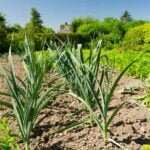Zone 6 vegetable gardening preparing soil for spring planting is essential for a successful harvest. Understanding the specific climate and soil conditions in Zone 6 is crucial for cultivating a thriving garden. From testing soil composition to choosing the right vegetables, there are several key factors to consider when preparing for spring planting in this region.
Zone 6 encompasses areas with cold winters and warm summers, making it suitable for a wide variety of vegetables. However, in order to make the most of this growing zone, it is vital to prepare the soil properly. Assessing the soil through testing and understanding its pH levels and composition will provide valuable insight into how best to prepare for spring planting.
Soil preparation techniques such as tilling, mulching, and composting are essential for creating a healthy growing environment for vegetables. These methods not only improve soil structure but also contribute to overall plant health and productivity. In addition to soil preparation, choosing the right vegetables that are cold-hardy and suitable for early planting will set the foundation for a successful growing season in Zone 6.
Assessing Your Soil
Importance of Soil Assessment
Before embarking on your zone 6 vegetable gardening adventure, it is crucial to assess the condition of your soil. Testing the soil will provide you with valuable information about its pH levels, nutrient content, and composition. Understanding these factors will help you determine how to best prepare your soil for spring planting, ensuring that your vegetables have the ideal environment for growth and development.
Soil Testing and pH Levels
One of the first steps in assessing your soil is to conduct a soil test to determine its pH levels. Most vegetables thrive in slightly acidic to neutral soil with a pH range of 6.0-7.0. If your soil’s pH level falls outside of this range, it may impact the availability of essential nutrients to your plants.
Fortunately, there are various at-home soil testing kits available that can provide you with accurate results within minutes. Once you know your soil’s pH level, you can take steps to adjust it if necessary by adding amendments such as lime (to raise pH) or elemental sulfur (to lower pH).
Understanding Your Soil Composition
In addition to testing for pH levels, understanding the composition of your soil is essential for successful zone 6 vegetable gardening. Sandy soils drain quickly but may lack nutrients, while clay soils retain moisture but can become compacted.
Loamy soils strike a balance between drainage and moisture retention and are often considered ideal for gardening. By evaluating the texture and structure of your soil, you can make informed decisions about which amendments and preparation techniques are needed to optimize its quality for spring planting.
By taking the time to assess and understand your soil through testing its pH levels and composition, you are laying the foundation for a successful zone 6 vegetable garden. Properly preparing the soil according to these findings will set the stage for healthy plant growth and abundant harvests throughout the growing season”.
Soil Preparation Techniques
When it comes to preparing the soil for spring planting in Zone 6 vegetable gardening, there are several techniques that can be utilized to ensure the best possible growing conditions for your crops. These techniques include tilling, mulching, and composting, all of which play a crucial role in maintaining healthy and nutrient-rich soil.
Tilling
Tilling is an important step in preparing the soil for spring planting. This process involves breaking up the soil to improve its texture and allow for better water and nutrient penetration. In Zone 6, it’s important to till the soil when it’s not too wet or dry to avoid damaging its structure. Additionally, incorporating organic matter such as compost or aged manure during tilling can help enrich the soil with essential nutrients.
Mulching
Mulching is another key technique for soil preparation in Zone 6 vegetable gardening. Mulch helps retain moisture, suppresses weed growth, and regulates soil temperature. Organic mulches like straw, grass clippings, or shredded leaves can also decompose over time to add valuable nutrients back into the soil.
Composting
Composting is an excellent way to create nutrient-rich organic matter for your garden. Incorporating compost into the soil improves its structure, fertility, and overall health. Compost also helps with moisture retention and reduces the need for chemical fertilizers. By starting a compost pile early on and allowing it to mature over the winter months, you’ll have a ready supply of compost to incorporate into your garden bed when spring arrives.
By utilizing these soil preparation techniques in Zone 6 vegetable gardening preparing soil for spring planting, you can set yourself up for a successful growing season with healthy and productive crops.
Choosing the Right Vegetables for Zone 6
When it comes to zone 6 vegetable gardening, the key to a successful harvest is choosing the right vegetables that can thrive in this climate. Cold-hardy varieties and early planting options are essential for ensuring a bountiful garden in Zone 6. Understanding which vegetables are best suited for this region will help you make informed choices when planning your spring planting.
In Zone 6, the last frost date typically falls between late April and mid-May. This means that you need to select vegetables that can withstand cooler temperatures and even tolerate light frosts. Some popular cold-hardy vegetables for Zone 6 include spinach, kale, lettuce, carrots, radishes, and peas. These hardy varieties can be planted early in the season and will continue to grow as the weather warms up.
In addition to cold-hardy vegetables, there are also early planting options that do well in Zone 6. These include crops like potatoes, onions, broccoli, cauliflower, and cabbage. While these vegetables may not be as frost-resistant as some of the cold-hardy varieties, they can still be planted early in the season with proper precautions such as using mulch or row covers to protect them from unexpected late frosts.
By selecting the right mix of cold-hardy vegetables and early planting options for your Zone 6 garden, you can set yourself up for a successful growing season. With careful consideration and planning, you can enjoy a diverse array of fresh produce straight from your garden throughout the spring and summer months.
Tips for Planting
When it comes to zone 6 vegetable gardening, preparing the soil for spring planting is essential for a successful and bountiful harvest. Proper soil preparation not only ensures healthy plant growth but also maximizes the potential of your garden. In this section, we will discuss important tips for planting your vegetables in Zone 6, including spacing, sunlight, and watering needs.
Spacing is crucial when it comes to planting vegetables in your garden. Each type of vegetable has specific spacing requirements to allow for adequate airflow and sunlight exposure. Here are some general guidelines for spacing common vegetables in Zone 6:
- Tomatoes: 18-36 inches apart
- Peppers: 18-24 inches apart
- Lettuce: 8-12 inches apart
- Carrots: 2-4 inches apart
In addition to spacing, sunlight is another critical factor to consider when planting your vegetables. Most vegetables require at least 6 hours of direct sunlight per day for optimal growth. Before planting, observe the sun patterns in your garden and plan accordingly to ensure that each vegetable receives enough sunlight.
Proper watering is essential for the health and productivity of your vegetable plants. In Zone 6, where summers can get hot and dry, consistent watering is crucial. The best time to water your vegetable garden is in the morning, allowing the foliage to dry out during the day and preventing any potential disease issues. Consider using a soaker hose or drip irrigation system to ensure efficient water delivery directly to the roots of your plants.
By paying attention to spacing, sunlight, and watering needs, you can set your Zone 6 vegetable garden up for success from the very beginning. These simple but crucial tips will help you create an environment that promotes healthy growth and abundant harvests throughout the season.
Protecting Your Garden From Late Frost
Late frost can pose a threat to your carefully tended crops, even in Zone 6. Taking precautions to protect your garden from late frost can make the difference between losing your entire crop and enjoying a bountiful harvest. Here are some essential tips for protecting your plants:
- Use Frost Cloth: One of the most effective ways to shield your plants from late frost is by using frost cloth. This specialized fabric allows sunlight, air, and moisture to penetrate while providing valuable insulation against cold temperatures. Simply drape the cloth over your plants when frost is expected, securing it with stakes or weights.
- Utilize Water Barrels: Water has a high heat capacity, meaning it can absorb and store a significant amount of heat. By placing water barrels near your plants, you can take advantage of this property to help moderate temperature extremes. The stored heat in the water will radiate out during the night, helping to keep nearby plants warmer.
- Choose Cold-Tolerant Vegetables: In addition to taking protective measures, selecting cold-hardy vegetable varieties can increase the likelihood of successful spring planting in Zone Some examples of cold-tolerant vegetables include kale, spinach, carrots, and radishes.
By implementing these precautions and being vigilant about monitoring weather forecasts, gardeners in Zone 6 can minimize the risk of damage from late frost and ensure a more successful growing season.
Remember that being proactive in protecting your garden from late frost will pay off with healthy, productive plants as spring progresses.
Maintenance and Care
Maintaining and caring for your Zone 6 vegetable garden is crucial to ensure a bountiful harvest. Fertilizing, weeding, and pest control are essential tasks that will help you maintain the health and productivity of your plants.
Fertilizing your soil is important to ensure that your vegetables have the nutrients they need to thrive. Before planting, it’s essential to amend the soil with compost or organic fertilizers to provide a good foundation for your crops. Throughout the growing season, you can continue to fertilize with natural options such as fish emulsion or seaweed-based fertilizers to promote healthy growth.
In addition to fertilizing, regular weeding is necessary to keep your garden free from competition. Weeds can steal vital nutrients and water from your vegetables, so it’s important to stay on top of this task. Consider using mulch or landscape fabric to help suppress weed growth and keep your garden beds tidy.
Pest control is another critical aspect of maintaining your Zone 6 vegetable garden. Keep an eye out for common pests such as aphids, cabbage worms, and cutworms, which can wreak havoc on your plants. Consider using natural methods like companion planting or introducing beneficial insects to keep pest populations in check.
| Maintenance Task | Tips |
|---|---|
| Fertilizing | Amend soil before planting and continue with natural fertilizers throughout the growing season |
| Weeding | Regularly remove weeds and consider using mulch or landscape fabric |
| Pest Control | Monitor for pests and consider natural methods for controlling their populations |
Extending the Growing Season
In conclusion, preparing the soil for spring planting in Zone 6 vegetable gardening is crucial for a successful and thriving garden. By assessing your soil, understanding its composition, and using proper preparation techniques such as tilling, mulching, and composting, you can create an ideal environment for your plants to grow. Additionally, choosing the right vegetables for Zone 6, considering cold-hardy varieties and early planting options, will help ensure a bountiful harvest.
When it comes to extending the growing season in Zone 6 gardening, utilizing row covers and cold frames can make a significant difference. These tools provide protection from late frost and help maintain warmth for your plants during cooler temperatures. By using row covers and cold frames strategically, you can effectively prolong your growing season and increase your yield.
Furthermore, ongoing maintenance and care are essential for the success of your Zone 6 vegetable garden. From fertilizing to weeding and pest control, taking proper care of your garden will promote healthy plant growth and minimize potential issues.
With the right preparation, selection of vegetables, and use of season-extending techniques like row covers and cold frames, Zone 6 vegetable gardening can be both rewarding and productive. By following these tips and techniques diligently, you can look forward to a successful growing season ahead.
Frequently Asked Questions
How Do You Prepare Soil for a Vegetable Garden in the Spring?
When preparing soil for a vegetable garden in the spring, it’s important to start by removing any weeds and debris. Then, loosen the soil with a tiller or garden fork to improve its texture and allow for better water and air penetration.
Adding organic matter like compost or aged manure can also help enrich the soil with essential nutrients for healthy plant growth.
What Do I Add to My Garden Soil Before Planting Vegetables?
Before planting vegetables in your garden soil, it’s beneficial to add organic fertilizers such as compost, well-rotted manure, or aged leaf mold. These amendments can improve soil structure, fertility, and microbial activity, which are all crucial for supporting healthy plant growth. Additionally, incorporating some balanced fertilizer based on your soil test results can provide essential nutrients.
How Do You Amend Soil for Spring Planting?
To amend soil for spring planting, start by testing the soil to determine its pH levels and nutrient content. Based on the results, you may need to add materials like lime to raise pH or sulfur to lower pH.
Incorporating organic matter such as compost or peat moss can also enhance soil fertility and improve its ability to retain moisture and nutrients. Mixing in some well-balanced fertilizer based on your soil test results can further ensure that the plants have access to required nutrients throughout the growing season.

If you’re looking to get into vegetable gardening, or are just looking for some tips on how to make your current garden better, then you’ve come to the right place! My name is Ethel and I have been gardening for years. In this blog, I’m going to share with you some of my best tips on how to create a successful vegetable garden.





